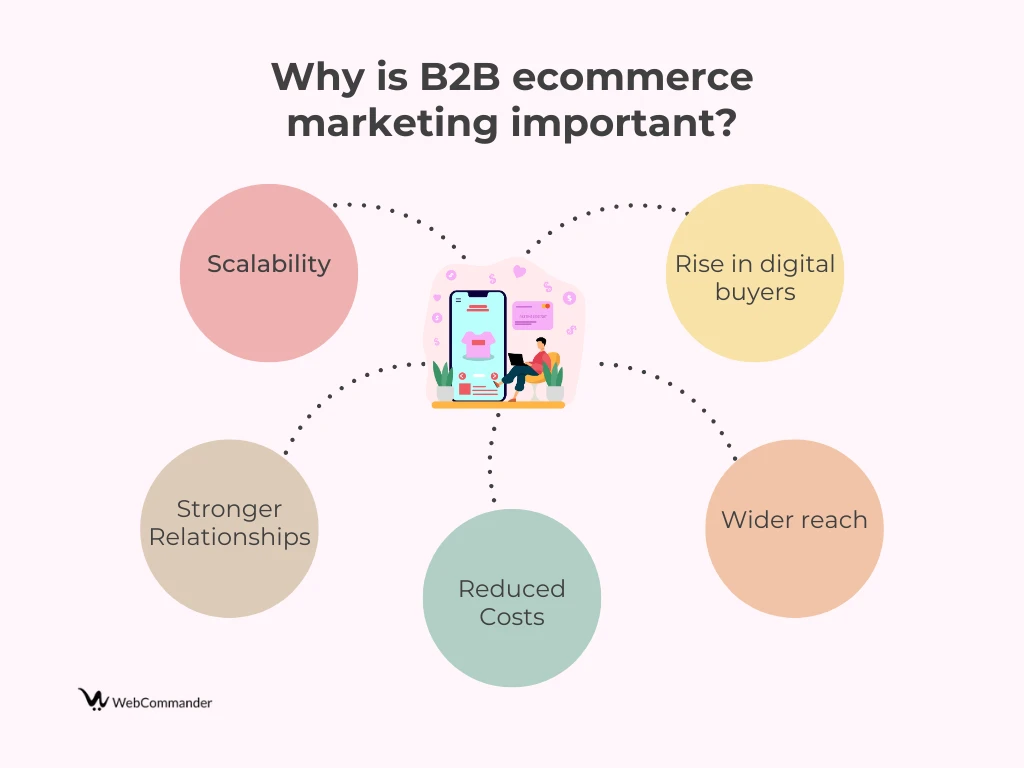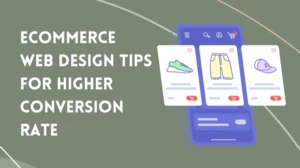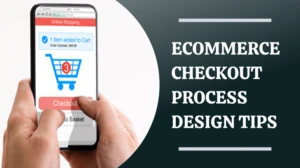A Comprehensive Guide to B2B Ecommerce Marketing
The world of B2B ecommerce is changing fast. Today's business deal doesn’t just rely on face-to-face meetings, phone calls or paper contracts. Most of the important purchasing decisions are happening online. This rapid shift has made B2B ecommerce marketing a powerful tool for driving growth, building trust and staying competitive.
What is B2B ecommerce marketing?
B2B ecommerce marketing is the art of using different marketing methods to connect with other businesses online. Simply put, it is the process of promoting and selling products or services from one business to another through an online platform.
The main goal is to:
- Reach the right customers (businesses)
- Build awareness of your brand
- Earn customer loyalty
- Drive sales
How is B2B ecommerce marketing different from B2C?
The one big difference between B2B and B2C ecommerce marketing is in the buying process. In terms of B2B, the process is longer as it involves various decision makers like finance teams, procurement managers and departmental heads. But in B2C, the buying process is pretty straightforward.
Another key difference is in purchase size and frequency. B2B customers usually place larger orders in bulk or on a recurring basis. But the B2C purchases are typically smaller and less predictable.
The nature of customer relationships is also not the same in B2B and B2C settings. In B2B, companies focus on building long-term partnerships, but in contrast, B2C ecommerce is centred on one-time or short-term transactions.
Why is B2B ecommerce marketing important?
Strong B2B ecommerce marketing is important for many reasons.

1. Rise in digital buyers
Nowadays, most of the business buyers prefer to research and place orders online instead of just relying on sales reps or phone calls. As they are used to the convenience of digital shopping in their personal lives, they look for the same smooth experience when buying for their company. This shift makes ecommerce marketing a must to stay competitive in the industry.
2. Wider reach
Ecommerce businesses aren't just limited to a local customer base. Marketing online makes it possible for businesses to connect with buyers across cities, regions, or even globally. This opens up new growth opportunities.
3. Reduced Costs
With digital marketing, you don't need to go for expensive traditional methods like printed catalogues, in-person meetings, or trade fairs. It also cut down on manual work, saving time and money.
4. Stronger Relationships
B2B ecommerce marketing makes it easier for businesses as they can stay connected with customers through follow-up emails, personalised offers, and self-service portals. This builds trust and long-term partnerships instead of just one-off transactions.
5. Scalability
Ecommerce marketing allows businesses to scale up quickly. Be it to handle more customers, to take larger order volumes, or to expand to new markets, digital platforms can grow alongside the business.
Best practices for creating a B2B marketing strategy
If you want to succeed in the competitive B2B landscape, you must follow proven best practices.
1. Map the business buyer's journey
You need to first understand the path your potential customers take. In the case of B2B, it is longer and more complex than in B2C.
The main stages are:
- Awareness
- Consideration and
- Decision
Awareness
In that stage, the buyers look for information but are not yet ready to purchase. For them, you can provide educational content like blogs, guides or infographics and position your brand as a helpful resource.
Consideration
Later, the buyers evaluate the vendors, pricing models, features and case studies. In this stage, it works best if you offer detailed product pages, comparison charts, and case studies that show why your solution is best.
Decision
Gradually, they narrow down the list of vendors and look at pricing, customer support and trust signals. You can provide clear pricing, free trials, testimonials and demos to remove any friction.
2. Pinpoint your ideal customers
You need to know exactly who you are trying to reach. Try to find out whether your products are best suited for small businesses, mid-sized firms or large enterprises. Then you can focus on industries where your solution can solve the problem.
You can create buyer personas, including job titles, responsibilities and pain points.
Also, instead of going for all, you can identify high-value companies and customise your outreach, messaging and offers to boost your chances of conversion.
3. Develop your marketing plan and strategy
Once you know your buyer, you must create a clear marketing plan to guide your actions in order to stay focused, avoid wasting resources and measure success.
You must decide what you want to achieve. Whether it is to generate qualified leads, boost online sales or grow repeat orders. Then, you can track the key metrics like conversion rates, cost per lead or repeat purchase rate to see the progress toward your goals.
Try to allocate budget and resources to decide how much you want to invest in SEO, paid ads, content creation or automation tools.
4. Build a powerful online presence
Your website is the first place where your buyers are going to interact with your brand. So, it needs to maintain a strong presence to look trustworthy. Include everything from clear menus to search functions to well-structured product categories, to make it easy to navigate.
Add detailed product information through descriptions, specifications, pricing options and high-quality images. Use clear CTAs, live chat support and inquiry forms for easy access while showcasing testimonials, case studies, and certificates to add more credibility.
5. Create your content and SEO strategy
In B2B ecommerce, both content and SEO go hand in hand. Alongside selling, you need to educate your buyers as well by sharing blogs, industry guides, videos or whitepapers to answer all common questions and solve pain points.
Identify all the long-tail and short-tail keyword that your targeted buyers uses when searching online. Then, inject those keywords naturally in titles, headings or descriptions. Keep your focus on site speed, mobile friendliness and structure if you want to rank high in SERP.
Plan for proper content distribution as well by sharing content across multiple platforms, covering LinkedIn, email newsletters, industry forums and more.
Later, you can track metrics like organic traffic, time on page and keyword rankings to measure the success of your strategies and improve your SEO effort.
6. Use multiple marketing channels
Do proper analysis in market research to find the most active channels. It can be LinkedIn, search engines, email, industry forums or offline trade events. You must keep your brand voice, visuals and messaging aligned to maintain consistency across channels.
Implement both organic and paid strategies. Alongside running SEO, blog posts and social content, run paid strategies such as Google ads, LinkedIn ads and other retargeting campaigns to get immediate visibility.
Use the analytics tools to detect the channel that drives the most traffic, engagement and conversions so that you can focus on high-performing channels while testing new ones.
7. Personalise the customer experience
It is a best practice to personalise the customer experience. In B2B ecommerce, personalisation goes beyond using a customer's name. The buyers look for tailored solutions that match their unique business needs, industry demands and purchasing behaviour.
You can use customer data such as purchase history, browsing patterns and engagement behaviour to recommend relevant products or services.
Also, you can tailor content targeting to roles and needs. As B2B requires bulk ordering and unique solutions, try to offer custom pricing and packages, volume discounts or flexible payment terms.
You can segment your communication by industry, company size or buying stage to send personalised emails, offers or product recommendations.
8. Measure your success for continuous improvement
In B2B ecommerce marketing, consider data as your strongest asset. You don't need to guess what works; rather, you can rely on analytics to understand buyer behaviour, measure performance, and refine strategies.
Monitor how visitors are interacting with your website and find out which pages they visit, how long they stay, and where they drop off. Then use the insight to improve navigation, content, and conversion pathways.
Track KPIs as well as compare the effectiveness of different campaigns and channels. Focus on current trends and demand so that you can align your marketing with industry-specific trends.
Some of the B2B ecommerce trends
- According to a report by Gartner, 80% of B2B sales are expected to come from digital channels, which will account for 56% of total revenue for B2B organisations.
- The global B2B eCommerce market is expected to reach $20.9 trillion by 2027.
- 83% of B2B buyers prefer to place orders and make payments through digital commerce channels.
- Today's B2B buyers now expect the same seamless personalised experiences as in B2C.
- Sustainability is becoming a fundamental value that influences B2B purchasing decisions.
Final words
As B2B ecommerce marketing is no longer optional, businesses need to invest in the right strategies- such as personalisation, multi-channel outreach and data-driven decision making. This will not just help them attract more customers but also build lasting partnerships.



![How to Start an Ecommerce Business in Australia [2023 Guide]](/template/5731a701/images/resource-blog-right-img1.png)





